Table of Contents
Foxface Fish : A Quick Summary
Foxface fish, also known as rabbitfish, are colorful saltwater fishes native to the Indo-Pacific region. They are popular in aquariums due to their striking appearance and peaceful nature. Foxface fish are herbivores and require a diet of algae and vegetables.
Foxface Fish Overview
The Foxface is a magnificent marine fish that can make an elegant addition to your marine aquarium. It is the kind of saltwater fish that usually does well, provided that the conditions in the tank are kept optimal for it. It is scientifically known as siganus vulpinus or simply as the Foxface rabbitfish. A very similar-looking species, Siganus unimaculatus, is called the One spot Foxface because they have a significant black mark on their sides. Common names for the Foxface fish include Fox rabbitfish, Foxface spine foot, and Foxface Lo. Like other Rabbitfish, the Foxface Rabbitfish is a herbivore and will spend its days grazing on algae & seaweed. BUT, some have also been known to be coral nippers.
It loves to eat algae, and one of the cool things about it is that it can help keep your tank free of algae. They are super colorful, and a group of them put together in one tank is just amazing to look at. However, don’t be fooled as there is a lot of care required when handling them.
| Information Chart | Foxface Fish |
| Scientific Name: | siganus vulpinus |
| Family: | Siganidae |
| Care Level: | Easy to moderate |
| Temperament: | Peaceful |
| Color: | Yellow |
| Lifespan: | Five years |
| Size: | 8-9 inches |
| Diet: | Primarily an herbivore |
| Minimum Tank Size: | 75 gallons |
| Temperature: | 75°F – 82°F |
| Water Conditions: | 8-12 dKh |
| Tank Mate Compatibility | Use caution when selecting tank mates. |
Foxface fish Appearance
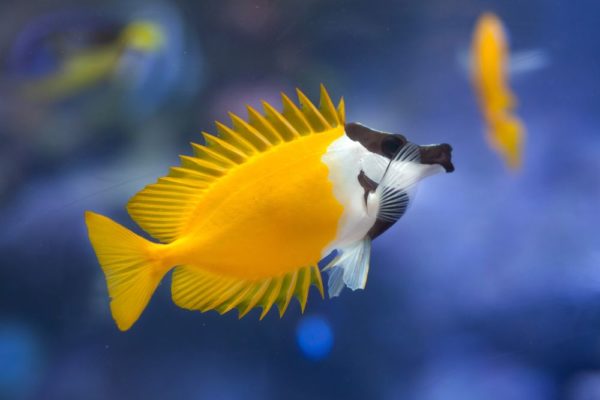
They are very colorful fish that will be the center of dominance in any aquarium they are added to. They have small mouths resembling the mouth of a hare with dark and large eyes that highlight their unique beauty. The face of the fish is light in color and shows a speckled coloration on the lower part. The body of the Foxface fish is mottled yellow-brown. It resembles a dark chocolate arc that runs from the first and second dorsal spines to the chin. Even its thorax has a dark chocolate tone. A narrow white blaze is visible on the head, and a broad white zone is visible on the trunk, right behind the ocular bar. The lower half of the head is speckled. The elongated snout of the fish makes it exhibit a look almost similar to that of a fox, the reason behind its name. The snout is equipped with venomous spines.
The lifespan of Foxface Fish
The average Foxface fish can live up to five years. If the fish is kept in healthy tank conditions, they can have a longer lifespan. With enough care and nutrition, these species can have a longer life.
Foxface Fish Size
The average Foxface fish grows up to 8- 9 inches. Although due to their domestication, these sizes can vary from fish to fish. The gender of the rabbitfish does not have much influence on their size. Males and females reach approximately the same size as adults.
Natural Habitat and Origin
The fish in the wild usually inhabit shallow lagoons in the tropical waters of the Western Pacific from approximately 30°N to 30°S. They are found in Indonesia and the far eastern Indian Ocean to the Marshall and Gilbert Islands north as far as Taiwan and New Caledonia and Australia. In Australia, it is found from Western Australia on the northern reefs and offshore reefs. This is a reef-associated species that live in lagoons and seaward reefs that have abundant coral growth. Thirty meters or 100 feet are the depth at which this can be found. They are usually found in coral-rich lagoons and seaward reefs. Since its natural habitat comes with low lighting, it likes spending most of its time in common light areas of the ocean, moving in between the coral reefs in search of its food.
Foxface Fish Care & Tank Set-Up
Foxface Fish Tank Size and Specifications
Optimum Tank Size for Foxface Fish
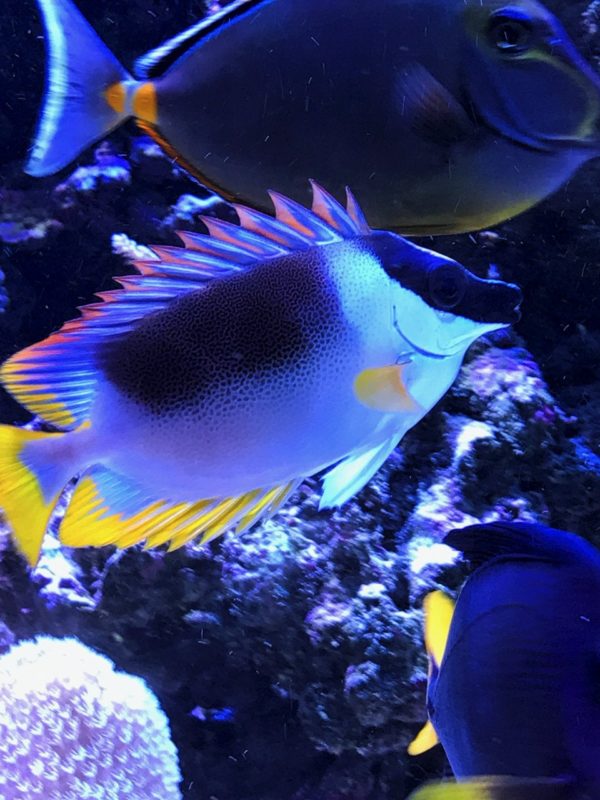
The recommended tank size for Foxface fish is 75 gallons minimum. Because the fish can grow up to 8-9 inches, huge tanks are required to ensure that they have enough space to swim around. Because the Foxface is a kind of marine fish that likes to swim a lot, providing a larger tank with sufficient swimming space is advised. For one fish, providing a tank that is at least 75 gallons or more is better.
Tank Shape for Foxface Fish
The tank shape isn’t essential for the fish. The only thing that it needs is enough space to swim around and hide. If this crucial requirement is provided, one does not have to worry about the tank shape.
Filter type for Foxface Fish
Since the fish lives in peaceful waters in their natural habitat, it is advisable to use filters that do not make the current of the water too strong. Any standard aquarium filters that do not increase the intensity of the waters can be used. Using strong filters would make it difficult for them to swim.
Substrate for Foxface Fish
The natural habitat of the Foxface fish is in regions with rocky snd coral materials. So, replicating this in the tank would always be beneficial. One can line the tank with rocky substrate and some corals. The fish is helpful for the tank because they eat up macroalgae growing on the corals and the rocky substrate.
How many Foxface fish are in a 75-gallon tank?
Since these fish tend to grow big and need a bigger tank to swim around, for one fish, providing a tank that is at least 75 gallons or more is better. It is a saltwater fish. Therefore, it should be housed in a marine tank. 2 fish can be kept in a 150-gallon tank, and so on. It is always essential to ensure that the tank is big enough for the fish to swim in. A crowded tank will hinder their growth. Additionally, the Foxface is a shy fish, and therefore you should provide rocks and cave-like structures where they can hide when they feel threatened.
Generally, this species prefers to spend most of its time near the bottom and middle. Sticking to the sides of the tank is what they do. Their favorite food is algae spots, and they often swim through corals. Remember that they are a bit territorial and may swim around an area of your tank that they have chosen.
Water Parameters for Foxface fish
Ideal water temperature for Foxface fish
The ideal water temperature for Foxface fish is 75°F – 82°F (25°C – 28°C). Anything below or above this would be uncomfortable for the fish. Water temperature is crucial because it provides a conducive environment for the fish to grow healthy and active. Remember, the fish inhabits tropical areas of the West Pacific in the wild, so you will need to provide an almost similar temperature. For the salinity level, it is best to set the tank between 1.020 and 1.025.
Water Flow Rate
Since the fish lives in lagoons and reefs in their natural habitat, they are acquainted with water flow rates that are slow, peaceful, and not very harsh. A harsh flow rate can make it difficult for them to swim around.
pH Level
The perfect water pH level for Foxface fish is 8.1 – 8.4. Maintaining the pH level is very important because it helps the fish grow in a healthy condition. Anything below the recommended pH level can be uncomfortable for the fish. One can bring home pH testing kits to ensure that the pH level is balanced and can balance the pH. A popular way of balancing the pH includes reverse osmosis (RO) or deionized (DI) water to create the desired pH and buffering. Some even use crushed coral or dolomite gravel to balance the pH level.
Water Hardness
The water hardness for the Foxface fish tank has to be 8-12 dKh. The Foxface fish lives in saltwater conditions in their natural habitat, so replicating this is always the best option. So remember to keep the water on the salty side.
Ensure that the water quality is stable because good quality water is vital for the health and survival of these fish while in captivity. It is susceptible to dirty water, and therefore the water must be kept clean at all times.
It is advisable to change between 10 to 25 percent of the tank water every month. If you wish to introduce more inhabitants to the tank, it is best to do it gradually rather than instantly.
Remember, the fish inhabits tropical areas of the West Pacific in the wild, so you will need to provide an almost similar temperature. For the salinity level, it is best to set the tank between 1.020 and 1.025.
Foxface Fish Tank Landscape
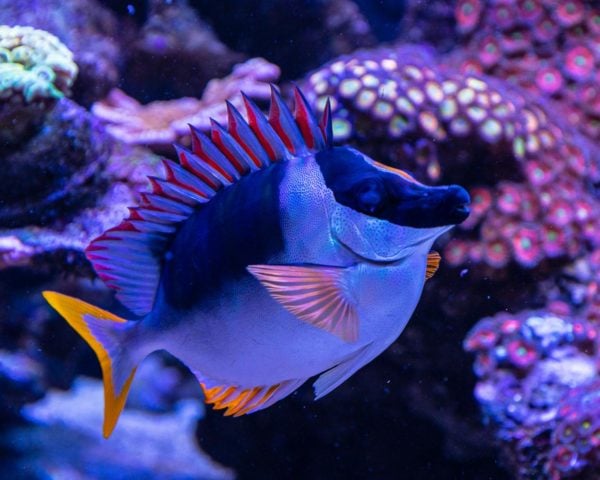
Best Plants for Foxface Fish Reintroducing Tanks
As mentioned above, since the species lives in lagoons and reefs, replicating this would always be beneficial for the fish. Plants like pickleweed, saltgrass, glasswort, etc., will be a great addition to your Foxface fish tank. Since the fish feeds on algae, adding algae to the tank will help the fish concerning their food.
Worst Plants for Foxface Fish Tanks
When it comes to the worst plants for the Foxface fish tank, plants that are usually considered toxic for the tank of other freshwater fishes should be avoided. These plants can be lethal for the fish.
Decorations for Foxface Fish Tanks
When it comes to decorations, one can add caves and tunnels in the tank. The Foxface fish loves to hide around in their natural habitat. Hence, replicating this would make the tank more comfortable for them. Avoid keeping any sharp metal objects in the tank because they can injure the dish.
Lighting for Foxface fish tanks
The reefs and lagoons usually have low lights and nothing too bright. It is always better to replicate this when setting up the tank for the Foxface fish. One can purchase low-lights for their tanks. Bright lighting can be uncomfortable for the fish.
Feeding Foxface Fish
Best Diet for Foxface Fish
Foxface Rabbitfish are primarily herbivores that feed on algae and zooplankton in the wild and feed on algae even when placed in a captive aquarium. When kept in a tank that has corals, there is a chance that the fish may occasionally nip on corals when they feel hungry, so don’t be surprised. The Foxface fish will dine on the natural buffet of the excellent and problematic algae in your tank. The best tank setup will have lots of rockwork, crevices, and surfaces for the rabbitfish to pick at and hide in when they feel threatened. Generally, though, it is recommended NOT to have a tank abundant with al. Since you anticipate that they will not be enough for a rapidly growing rabbitfish, consider using fresh vegetables, algae sheets, or algae flakes/pellets. One of the dangers of the species is that if they are hungry, they will nibble on the corals in the tank. So, keeping well-fed is always a healthy option. The different kinds of food that you can give to your Foxface fish includes Flake food, Fish pellets food, Fresh vegetables, Algae, and Dried seaweed. One can also give them seaweed every once in a while. The fish will happily accept live foods, frozen foods, pallets, and flakes.
How often should you feed Foxface fish?
The Foxface fish should typically be fed a few times a day. Remember that the fish are faster eaters, so it is always better not to give them too much food in one go because this might be unhealthy. Providing them with a small amount of food every once in a while will be the best option. If you cannot dedicate too much of your time to feeding them, you can purchase an automatic fish feeder to make this process hassle-free and ensure that your fish isn’t hungry.
Foxface Fish Behaviour and Temperament
Are Foxface fish lone or societal?
The Foxface fish is a peaceful herbivore that is protected by venomous spines.
No aggressive behavior has been observed with the Foxface fish; they are generally peaceful fish species that readily live with other tank mates. The good thing with them is that they are herbivores and will not attempt to feed on other fish species housed together with them. It is important to note that when the fish grow and mature, they tend to establish territories, and it is best to keep a male and female pair in one tank. It is claimed that a male a female Foxface couple will form a long-lasting bond until one pair dies. The Foxface Rabbitfish occurs singly and in pairs and can be territorial. It is believed that fish include a team when they are 10 cm / 4 in long, and the pair lasts until one of them dies. In addition to forming large schools, juveniles and sub-adults feed on algae that grow on dead coral branches on the bases of corals and hide among Acropora corals.
Foxface Fish Tank Mates
Ideal Foxface fish tank mates
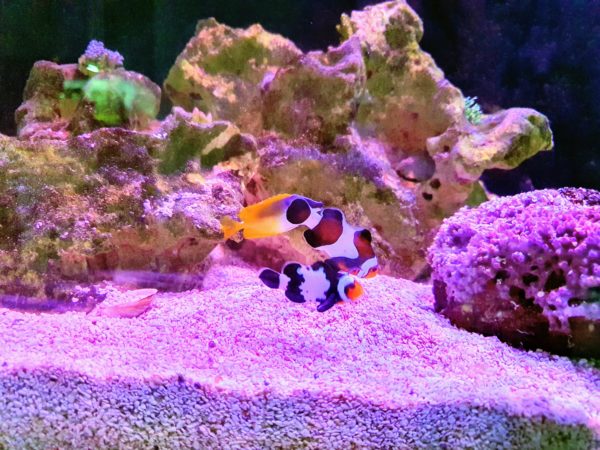
As mentioned above, the fish comes with a venomous spine. So, they make a perfect choice for a tank with cleaner shrimp or small fish, or aggressive species. However, the spines are not protective vests, so it is always better to avoid mixing them with aggressive species that can mismatch in size or behavior. Keeping other kinds of rabbitfish is always a good option.
Bad tank mates for Foxface fish
The fish’s temperament is peaceful, and therefore it makes a great candidate ideal for a community tank. The good news is that even predatory members of the tank will be scared of it due to its venomous spines. This is a survival adaptation that helps it keep potential predators at bay! These fish are not suitable for keeping with Zoa’s, Paly’s, or any other large polyp coral.
Please remember that it is only best to keep the fish in a community tank when still young, but it is best to keep it alone or with a mate in a different tank when it is mature.
It must be noted that the fish has got spines that are venomous that can inflict excruciating stings on the hands. This, therefore, calls on hobbyists to be careful when it is necessary to handle the fish. If you get stung by the fish, you should seek immediate medical attention from a healthcare expert!
If, for instance, it feels threatened, stressed, or acclimatizing to a new environment, then Foxface can change color. They are the exact coloration at night and dig their spines into a rock to hold themselves in place to maintain their safety from predators.
When acclimating your fish, place them in a bucket and drip accommodate for about 60 minutes at the rape of 3 drops. They are per second. This will bring the fish’s water parameters to the parameters of the tank. Once the fish has been acclimated, catch them with a net and gently place them into your tank. It is essential to remember that you should not put any of the fish that initially came into the tank.
The Foxface Rabbitfish can look discolored when it is acclimatizing to a new home. This should not be perceived as an illness. It can develop spots, but they will go away when the fish feels more at home and has grown accustomed to the conditions in your aquarium. Alternatively, the marks may also appear if the aquarium light is suddenly turned on or if the fish is stressed by something, such as poor water quality or aggressive tank mates.
The fish is capable of spewing venomous spines, so they must be handled with utmost care.
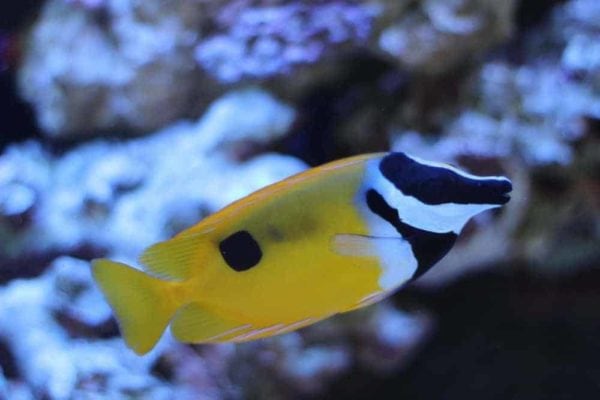
Breeding Foxface Fish
Breeding Level
Easy to Moderate (Ideal for saltwater beginners)
Foxface fish sexual dimorphism
There is no defined way to find out the difference between male and female species of this fish. Since it is difficult to deter this species the gender identity, we can say that they are hermaphrodites.
There has been no reported success in breeding the Foxface fish in captive aquariums, and usually, most of those available for the hobby are either caught in the wild or raised in unique fish farms. The fish females generally scatter their eggs in a somewhat mating ritual that occurs in the mid-water positions. After fertilization, the resulting egg can attach to plankton in the water and finally end up settling on the reef at the bottom. This fact makes it difficult to breed the fish in captivity, and many attempts that have been made to achieve this haven’t been fruitful either.
Common diseases and their treatment
The Foxface Fish are hardy, and hence they are pretty resistant to diseases. However, if your fish does fall prey to any common saltwater fish disease, it is always better to quarantine this fish in another tank to avoid the spread of infections. Keep them in the quarantine tank for a week or two and always watch out for common saltwater diseases like marine ich.
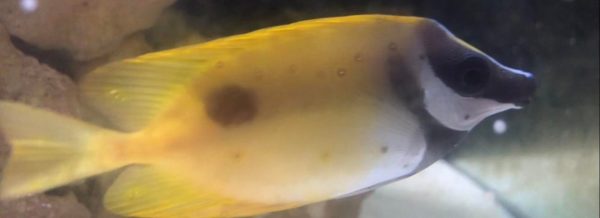
It is usual for the Foxface to get scrapes, but they usually heal within a few days unless there is a secondary bacterial infection. Furthermore, it is essential to note that the Foxface sheds its slime coat occasionally, which is one of the reasons it is so disease-resistant.
Are Foxface fish right for you?
The Foxface rabbitfish is a beautiful fish that is wonderful to look at and would be a spectacle in your tank. However, it is difficult to handle due to the poisonous spiked fins and requires extra care in its tank environment. On the positive side, they will help in increasing the aesthetic value of the tank.
FAQ
Q. Are the Foxface fish venomous?
Yes, the Foxface fish is venomous because they have poisonous spiked fins.
Q. How many fox fishes should I keep in a tank?
Having just one fish in your tank is not suggested. You can keep two or three in a tank that is big enough to handle them.
Q. Can the Foxface fish fall sick?
They are very hardy, so they do not fall sick very often. However, if they do show some signs of saltwater disease, then remember to quarantine them.
Conclusion
The Foxface fish is a saltwater aquarium fish that is practically perfect. Bold, robust, and simple to feed. It’s peaceful and gets along with both shy and semi-aggressive fishes. This vividly colored fish has a lot of admirable traits. They’ll even clean your tank for you if it’s infested with algae. Just be confident that you:
Make sure you have a tank big enough to hold them as adults.
Keep your hands away from their deadly spines.
To keep them from biting at corals, feed them regularly.
No related posts.
